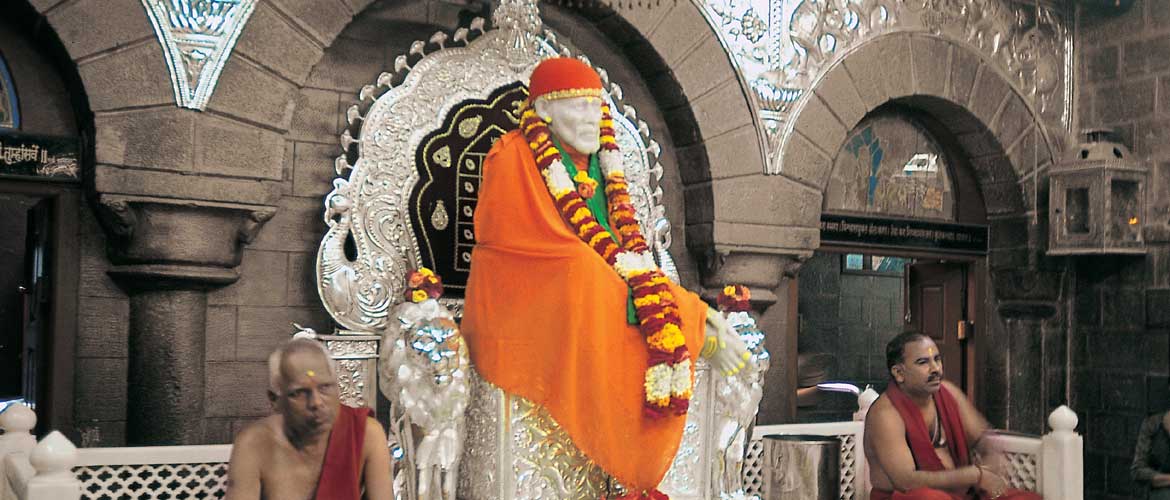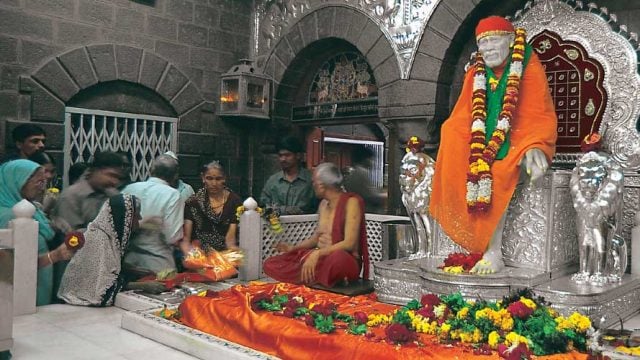On 15 October, 1918, Sai Baba attained samadhi (salvation, not death), but in Shirdi his
The deep bass of drums, the higher octave of prayer bells and cymbals seeking divine attention, the rhythm of the pujari’s chants, all make for an enthralling spectacle.
Things to See & Do
Distances seem exaggerated in Shirdi. What is referred to as the other end of town is, in reality, a breezy 10-minute walk through narrow lanes fringed by stalls selling flowers, sweets and other items that devotees offer to Sai Baba.

Samadhi Mandir of Sai Baba
In this shrine, a life-sized Italian marble statue of the saint presides. There is invariably a long line of devotees waiting for a darshan. Be prepared to wait for up to three or four hours on Thursdays, the special day of the saint, and on weekends, holidays and during festivals. Since the temple has a limited capacity, entrance is on a first-come basis. This means getting there early or obtaining a special VIP pass from the Sansthan office the previous day.
Aarti Timings 4.30am, 12.00pm, sunset & 10.30pm
Dwarkamai
This is the mosque where the 20-year-old Sai Baba took up residence in 1858 when he first arrived in Shirdi, and where he spent the remainder of his life. The two-level structure houses portraits and relics of Sai Baba and some items of everyday use that belonged to him.
Chavadi
To the east of Dwarkamai is the place where Sai Baba slept on alternate nights. It contains the wooden bed and white chair that were used by him.
Thursday Palki Procession
Every Thursday, a palkhi procession is taken through the streets of Shirdi. A framed photograph of the saint, along with the slippers he wore, the chillum (traditional pipe) he smoked and the stick he carried, are taken out on a palanquin hoisted on the shoulders of priests. The procession starts at 9.00pm from Samadhi Mandir and proceeds to Dwarkamai and then back to the main temple.
Gurusthan
This is a shrine built around a neem tree under which Sai Baba sat when he first came to Shirdi. In front of the portrait of Sai Baba enshrined here is a shivalinga and a Nandi bull. Photographs of the 12 jyotirlingas are also kept in the temple.
Lendi Baug
This is a small garden that was watered every day by Sai Baba, who would rest under the neem tree here.
The samadhi of Shyamsunder, a horse that would bow whenever it passed Sai Baba, is also located here.
The Information
When to go All year round
Information, Executive Officer, Shri Sai Baba Sansthan, Shirdi, Tel: 02423-258500, shrisaibabasansthan.org
Tourist Office
MTDC, Shirdi, Tel: 02423-255194-96
STD code 02423
Getting There
Air Nearest airport: Aurangabad (130km/ 3hrs). Taxi fare ₹3,000–3,500
Rail Nearest railheads: Sainagar (2km); Kopargaon (13km/ 20mins). Taxi ₹1,100–1,500. However, the most convenient connection is with Manmad (57km/ 1.5 hrs). Taxi ₹1,500–2,000
Road From Nashik take SH10 via Sinde, Sinnar, Vavi and Zagade phata Bus Plenty of ST buses ply to Shirdi from all major cities in Maharashtra
Maharashtra
Sai Baba
temple



